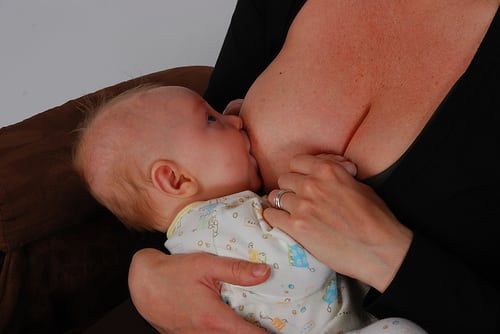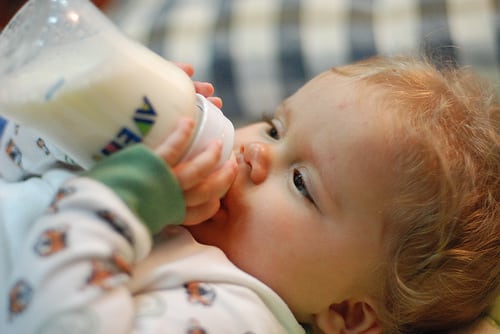Image by Mothering Touch
Once your baby is born, s/he will obviously need to eat. Many women choose to initiate breastfeeding (about 75% in the US currently). However, by 3 months, only 35% are being exclusively breastfed, and by 6 months, only 15% are exclusively breastfed (44% receiving “any breastmilk”). About 24% of babies are still receiving some breastmilk at 12 months. There are no stats beyond this age.
Clearly, there are a lot of different choices out there in infant feeding, breastfeeding being just one of them. Before choosing what’s best for your baby — and there are a lot of factors that go into this — it’s best to know what all the options are and the benefits and drawbacks of each.
Breastfeeding as an Infant Norm
The biological norm is for infants to be breastfed. Although we support all mothers in the choices they make, we would be remiss not to advocate for breastfeeding, at least for the majority of women.
Breastfeeding is the healthiest way for babies to begin life. This is for many reasons, a lot of which we do not understand yet. Here is just a brief summary:
- Breastmilk provides an immune system for infants who don’t yet have their own, protecting their health
- Breastmilk contains living stem cells
- Breastmilk helps the baby’s gut to mature, which can prevent allergies
- Breastmilk may protect against obesity, diabetes, and other conditions later in life
- Breastmilk is the perfect food for each baby; it changes with age, time of day, if exposed to illness, and other needs
- Breastfeeding protects against breast and ovarian cancer in both baby and mother
- Breastfeeding promotes proper jaw development
There have been a few studies recently that have shown conflicting information about the points above. I do not take those seriously.
First, there is an overwhelming body of evidence showing those things to be true.
Second, God designed mothers to produce milk and babies to be nourished with that milk. All the studies in the world can’t change that.
Third, mothers these days are not always as healthy as they should be. Mothers who have undiscovered food allergies may be passing undigested proteins to their babies, causing sensitized guts and possibly priming them for allergies and other issues. This is not normal, however. It is happening because of our poor modern diets and general lack of health. The research is uncovering modern issues, not a biological norm.
Check out this chart of all the components of breastmilk. And this is only what is known! Breastfeeding, because it is so much more than just food, and because the act of breastfeeding itself promotes weight loss in the mother, is protective against types of cancer, promotes proper oral development, and much more, should be seriously considered by every mother.
Image by Mothering Touch
Common Myths About Breastfeeding
This is not aimed at women who have a legitimate excuse for not breastfeeding, nor is it intended to judge women who choose not to breastfeed for any reason.
Unfortunately, a lot of women receive very poor advice from mothers, friends, and even doctors, nurses, and lactation consultants, which hinder their breastfeeding efforts. Women deserve access to real support and not to fall victim to common myths about breastfeeding. Many women really want to breastfeed, but come to believe they can’t because all of the support or information out there is stacked against them. Women who want to breastfeed and who are physically capable should have access to correct information.
These are common pieces of advice given to new mothers, which may negatively impact breastfeeding, and which are false.
Too Little Milk (Early Days)
Some say that “you just don’t have enough milk and your baby is hungry” in the first day or two after birth. Babies are not meant, at this time, to eat very much. They are meant to be put to the breast frequently, though. It is not uncommon for babies to want to eat every hour or two, sometimes more often than that. They are learning to breastfeed and their tummies can only hold a teaspoon or two. This quickly expand over the next several days so that they can hold 2 – 3 oz. per feeding, but by this time mother’s milk has come in and she is able to produce what baby needs. If baby is crying, it may be from a need to nurse more frequently, because of a poor latch, tongue tie, or an issue unrelated to nursing.
Too Little Milk (After Mature Milk is In)
While this legitimately happens to some women (see below), a lot of women are told this when it is not true. First, it is important to know that what you can pump is not an indication of what you are producing for your baby. Some women do not respond well to a pump and may get basically nothing, but that does not mean their baby is starving. Some babies may cry because of a need to nurse more frequently, or because they are not latching well, have a lip or tongue tie, or otherwise need nursing help (and if these are not helped, they can eventually negatively impact milk supply). Some babies may be crying for reasons unrelated to nursing. As long as baby is having several wet and dirty diapers per day and is gaining weight steadily (after the 4th – 5th day of life; some babies lose a bit at first), there is no reason to be concerned about inadequate milk supply.
Limit Baby’s Nursing Time/Create a Schedule
Some well-meaning people say to put baby on a 3- or 4-hour schedule between nursing sessions, or to limit baby to 10 minutes per side. This is either to try to prevent soreness in the mom or because some people believe babies are better off on a schedule. Unfortunately, limiting nursing time may impact the body’s ability to adapt to the baby’s demands for milk. Especially in the first 12 weeks, while your body is adjusting, it is important to let your baby nurse whenever s/he wants and for as long as s/he wants. This may be 10 – 15 minutes (especially once baby is older and more efficient), but it can easily be 45 minutes while baby is learning. Allow the baby to nurse as needed. There are other ways to combat nursing soreness if mom is having a problem (and soreness may be an indication of poor latch, so check on this if you suspect an issue).
Breasts Too Small/Too Large
A mother’s ability to produce milk is based on the amount of milk ducts and glands inside her breast, not the fatty tissue that surrounds it. Mothers with larger breasts may be able to “store” more milk, but that does not mean they make less milk. A mother with larger breasts will not suffocate her baby. Proper positioning will prevent this. In general, breast size and breastfeeding abilities are not related.
Pump/Pacifier Use
Some moms are advised to pump for their babies in the very early weeks, or to use a pacifier to comfort them because “they are just using you as a pacifier.” Some babies can handle this just fine and will suck on anything (mine did!), but others get “nipple confusion” and will refuse to breastfeed. This is especially true in the very early weeks while baby is just learning to latch and breastfeed well. It’s a good idea to wait until the breastfeeding relationship is well established, which may be anywhere from a few days to several weeks, before introducing bottles or pacifiers. Babies do not “use you as a pacifier;” they use a pacifier as a substitute breast. They are meant to nurse frequently especially when they are brand new, and no, this will not “spoil” them.
A Little Formula Won’t Hurt
Now. If you have tried everything to feed your baby and you are both in tears, you can’t pump or have no access to a pump, you can’t call anyone to help baby latch and baby won’t try, and baby is starving…a bottle might help you both calm down so that you can try again in a few hours. This will not mean an end to your breastfeeding relationship if you are determined to try again as soon as everyone is calmer. However, a lot of people say this because they want a new mom to leave her baby for a few hours, or they want dad or Grandma to be able to feed the baby, just for “fun” (i.e. there is no issue/necessity). A little formula can change baby’s gut health permanently and delay or prevent proper maturing. If there is no reason to give formula, then don’t. Some babies may also be allergic or sensitive to formula, and for those who choose to use it, the proper brand/type needs to be selected carefully. It isn’t something you just “give to baby” because Grandma wants a turn. Let Grandma change the next diaper instead!
Formula is Better/Breastmilk is Bad
Some people actually believe that formula is nutritionally superior to breastmilk, or that breastmilk is in some way bad for babies. This is just flat-out wrong. There is no evidence to support that, in general, formula is nutritionally superior. Breastmilk is what babies were born to eat — period. (That does not mean there are not very few circumstances in which breastfeeding is not a good idea for certain moms/babies, but this blanket statement is false.) Some think that formula is better because it will make babies sleep longer. Babies under 4 months of age are not meant to sleep long and deeply — doing so can increase the risk of SIDS. There is *no* reason to use formula without a medical need in order to trick baby into sleeping longer, going longer between day time feeds, or any other nonsense. Formula is for babies who need to have it, it does not improve the lives of successfully breastfeeding babies in any way.
Image by bradleyolin
What if Breastfeeding Isn’t Possible?
There are situations in which breastfeeding is not possible. Some women do not produce much, if any, milk.
I know, I know…lactation consultants and other advocates like to say that’s not really possible because our species would have died out long ago (at least if the proportion of women who say they can’t produce enough milk today was the same 100 or 1000 years ago). But again…this is a modern problem, caused by a lot of environmental changes.
Women may not produce enough milk today because they have adrenal issues, thyroid issues, or other hormonal imbalances. These are far more common today than they used to be, due to all the medications, chemicals in plastics and pesticides, and other endocrine disruptors in our environment. Sometimes these factors suppress milk production and cannot be overcome — or at least not soon enough to breastfeed one’s current baby.
(If it turns out you have this issue, you can address it before having another baby, and you may be able to breastfeed in the future! Changing your diet, supplementing with magnesium and vitamin D, working with a health practitioner to balance your hormones, etc. may help you to produce milk in the future. Don’t rule it out!)
Other women are on certain medications (like anti-seizure medications) which are contra-indicated with breastfeeding. Still others have work situations that are difficult, or emotional reasons for not breastfeeding.
For these women, they need to know what options are out there and learn what is safe.
Image by Joe Schlabotnik
Commercial Formula
Most women choose a commercial formula, either milk- or soy-based. There is some evidence that soy-based formulas are very high in estrogen and may not be a good option for babies. They should not be a parent’s first choice. Also, read labels carefully — many formulas contain GMO corn and soy (even milk-based varieties). Formula ingredients in a popular brand:
Corn Syrup, Sugar, Milk Protein Isolate, High Oleic Safflower Oil, Soy Oil, Coconut Oil, Galactooligosaccharides. Less than 2% of the Following: C. Cohnii Oil, M. Alpina Oil, Beta-Carotene, Lutein, Lycopene, Calcium Phosphate, Potassium Citrate, Potassium Chloride, Sodium Citrate, Magnesium Phosphate, Ascorbic Acid, Calcium Carbonate, Choline Chloride, Ferrous Sulfate, Magnesium Chloride, Ascorbyl Palmitate, Choline Bitartrate, Taurine, m-Inositol, dl-Alpha-Tocopheryl Acetate, Zinc Sulfate, Mixed Tocopherols, L-Carnitine, Niacinamide, Calcium Pantothenate, Vitamin A Palmitate, Cupric Sulfate, Thiamine Chloride Hydrochloride, Riboflavin, Pyridoxine Hydrochloride, Folic Acid, Manganese Sulfate, Potassium Iodide, Phylloquinone, Biotin, Sodium Selenate, Vitamin D3, Cyanocobalamin, Potassium Hydroxide, and Nucleotides (Adenosine 5’-Monophosphate, Cytidine 5’-Monophosphate, Disodium Guanosine 5’-Monophosphate, Disodium Uridine 5’-Monophosphate).
This is basically mostly sugar (corn syrup and sugar being the two top ingredients — both likely GMO, as this is not an organic brand). Followed by safflower and soy oils (soy also being GMO). Most of the ingredients in the “less than 2% of” category are synthetic vitamins and minerals.
Be aware of the ingredients in commercial formula. It may or may not be the best choice for your non-breastfed baby.
Organic Formula
There are also organic formulas out there (commercially), which avoids the problem of GMO ingredients. Here are the ingredients in a popular organic brand:
Organic Brown Rice Syrup, Organic Nonfat Milk, Organic High Oleic Sunflower and/or Organic High Oleic Safflower Oil, Organic Soybean Oil, Organic Coconut Oil, Egg Lecithin (Source of DHA & ARA), Organic Vanilla, Calcium Phosphate, Potassium Citrate, Calcium Ascorbate (Vit. C), Organic Soy Lecithin, Calcium Citrate, Choline Bitartrate, Taurine, Ferrous Sulfate, Inositol, Vitamin C Palmitate, d-Alpha Tocopheryl Acetate (Vit. E), Natural Mixed Tocopherols, Zinc Sulfate, Niacinamide, Vitamin A Palmitate, Calcium Pantothenate, Thiamin Hydrochloride (Vit. B1), Copper Sulfate, Riboflavin (Vit. B2), Pyridoxine Hydrochloride (Vit. B6), Folic Acid, Phylloquinone (Vit. K1), Potassium Iodide, Sodium Selenate, Biotin, Vitamin D3, Cyanocobalamin (Vit. B12).
This is still not really a “whole foods” option, relying heavily on brown rice syrup (grains are not so good for babies). It also contains both dairy and soy, and many synthetic nutrients.
Hypoallergenic Formulas
For babies with allergies, a hypoallergenic formula may be required. There are specific “sensitive” brands (like Alimentum), and then there are elemental formulas for babies with severe problems (like Elecare). Here are the ingredients in an elemental formula:
Corn Syrup Solids (55%), High Oleic Safflower Oil (9%), Medium-Chain Triglycerides (8%), Soy Oil (7%), L-Glutamine (2%). Less than 2% of the Following: C. Cohnii Oil, M. Alpina Oil, L-Asparagine, L-Leucine, L-Lysine Acetate, DATEM, Calcium Phosphate, L-Valine, Potassium Phosphate, L-Isoleucine, L-Arginine, L-Phenylalanine, L-Tyrosine, L-Threonine, Potassium Citrate, Sodium Citrate, L-Proline, L-Serine, L-Alanine, Glycine, L-Histidine, L-Methionine, Ascorbic Acid, Magnesium Chloride, Calcium Carbonate, L-Cystine Dihydrochloride, L-Tryptophan, Salt, Choline Chloride, m-Inositol, Ferrous Sulfate, Taurine, Ascorbyl Palmitate, Zinc Sulfate, dl-Alpha-Tocopheryl Acetate, L-Carnitine, Niacinamide, Calcium Pantothenate, Thiamine Chloride Hydrochloride, Cupric Sulfate, Manganese Sulfate, Vitamin A Palmitate, Riboflavin, Pyridoxine Hydrochloride, Folic Acid, Beta-Carotene, Biotin, Phylloquinone, Chromium Chloride, Potassium Iodide, Sodium Selenate, Sodium Molybdate, Vitamin D3, and Cyanocobalamin.
These formulas are basically corn syrup (not okay for babies with corn allergies), amino acids, and synthetic vitamins.
Homemade Formulas
Another option out there is a homemade formula. There are different recipes out there, and they’re usually based on cow’s or goat’s milk. Either of these options will need to be diluted, as they contain too much sodium for baby’s immature kidneys. Most recipes take this into account. The recipes use milk, and add sources of carbohydrates and fats, with healthy oils and sometimes ingredients like molasses or maple syrup (in small amounts).
Many doctors and health professionals discourage the use of homemade formulas. Since they make up the bulk or entirety of a baby’s diet, caution does need to be exercised. Health professionals are often worried that babies will not get adequate nutrition and that they may be harmed in some way.
However, there are many stories of babies thriving on homemade formulas. Some babies have done better on homemade formula than on commercial options. Parents must be careful to choose a recipe that they feel they can trust, prepare it and store it carefully, and assess frequently if baby needs a change or additions (based on stool, urine, behavior, etc.). Finding an alternative health professional who may be able to guide you in this area, if one is available, can be helpful.
Although I have not yet personally faced this decision, I would choose a homemade formula if I were unable to breastfeed.
The Weston A. Price homemade formula recipe:
- 2 cups whole raw cow’s milk, preferably from pasture-fed cows
- 1/4 cup homemade liquid whey (See recipe for whey, below) Note: Do NOT use powdered whey or whey from making cheese (which will cause the formula to curdle). Use only homemade whey made from yoghurt, kefir or separated raw milk.
- 4 tablespoons lactose1
- 1/4 teaspoon bifidobacterium infantis2
- 2 or more tablespoons good quality cream (preferably not ultrapasteurized), more if you are using milk from Holstein cows
- 1/2 teaspoon unflavored high-vitamin or high-vitamin fermented cod liver oil or 1 teaspoon regular cod liver oil3
- 1/4 teaspoon high-vitamin butter oil (optional)1
- 1 teaspoon expeller-expressedsunflower oil1
- 1 teaspoon extra virgin olive oil1
- 2 teaspoons coconut oil1
- 2 teaspoons Frontier brand nutritional yeast flakes1
- 2 teaspoons gelatin1
- 1-7/8 cups filtered water
- 1/4 teaspoon acerola powder1, 2
If you are concerned about sourcing all these ingredients, Radiant Life sells a formula-making kit (or click the links to buy). If you are concerned about cost, check out my chart on formula cost comparisons.
Ultimately, you, as the parent, must choose the best option for feeding your baby. All of this information is provided so that you are aware of the options that are out there and can make an informed choice. Please seek the advice of a medical professional if you uncertain about the best path for your family.
**This post has been entered in Frugal Days and Sustainable Ways.**







I feel like a few things were left out. I was unable to nurse my son because of several issues with him transferring milk. I did the best I can for 8 weeks (until my husband deployed) going to 6 IBCLCs/LCs, occupational therapists, doctors, cranial sacral therapists, etc. The entire time, I nursed and pumped and supplemented with pumped milk around the clock. If I didn’t, he lost weight.
Finally at 7 weeks or so, I had to make a choice. I couldn’t do what I did with my husband gone for 2 months and the nearest family 1500 miles away and keep myself, the baby, and two dogs cared for.
Formula was never an option for me. From that point on, I exclusively pumped. I kept my son in 100% breastmilk until his birthday. Now, at 15mo, he still gets some frozen breastmilk. It wast easy. I needed herbal help at times, and towards the end used Domperidone, but I did it! Not a drop of formula.
I wish exclusive pumping was more openly talked about and shared as an option. It doesn’t have to be breast or formula. There are options.
I do understand that you were talking about moms who didn’t produce enough or had to take medication. I am still surprised donor milk wasn’t listed as a possible option. Even the WHO says the order of best milk options is 1:moms milk, directly. 2: moms milk, expressed. 3: donor milk. 4: formula
I wanted to add that many women can’t bf after a reduction. I was told it would diminish my changes of bfing succesfully by 20%, but it was much more than that. I had my first 3 year after the surgery and produced nothing. The second was 5 years later and there were drips. My third was 10 years later (and I was told that after 10 years the mammary glads heal themselves) but still only produced 3 oz a day (we weighed him after each feeding at 1 month).
I also want to comment about homemade formula. We did it for my third. He was doing great on it, but after awhile his urine output got to maybe 4 pees a day (never a soaked diaper). We put him back on commercial and it increased. For whatever reason he just wasn’t able to handle it. So I say definately try for all those moms who can’t bf, but PLEASE watch their urine output. After that, we used Whole Foods 365 Organic brand.
[…] Modern Alternative Pregnancy’s Informed Consent on Infant Feeding […]
[…] Informed Consent in Infant Feeding : Modern Alternative Pregnancy […]
[…] MAK – Informed Consent In Infant Feeding […]
[…] Informed Consent in Infant Feeding […]
I nursed because I knew it was better and because it was free. However, I often wanted to quit. My daughter can’t eat soy, rice, corn, or dairy. It was a long and difficult 15 months figuring out what was causing her to be sick. However, we are still nursing at 20 months and her tummy is wonderful. Hopefully she grows the food issues. However, they are what pushed me to whole/real food. I didn’t know anything but SAD and wonder if I had been eating right all along if she wouldn’t have food issues…..
[…] your baby is born, s/he will need to eat.
[…] Informed Consent in Infant Feeding : Modern Alternative Pregnancy […]
[…] breastfeeding over bottle feeding whenever possible.